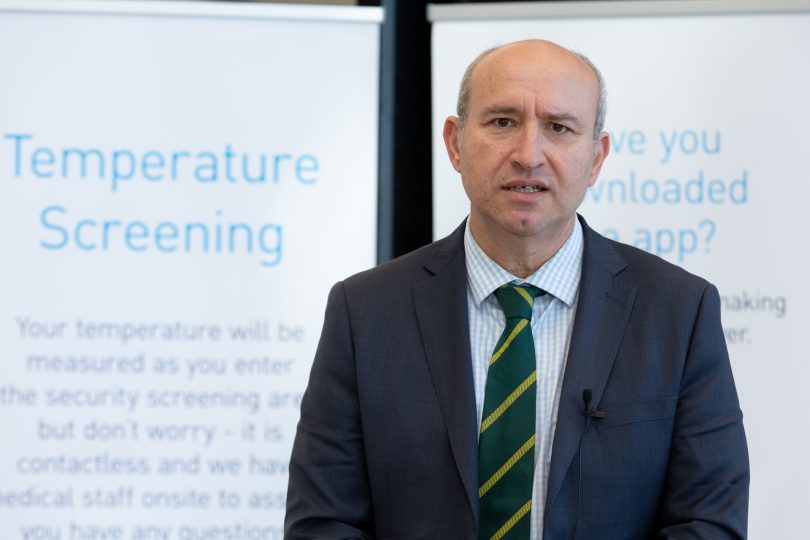
An operator focuses on a subject during the security check at Canberra Airport departures. Photos: Michelle Kroll, Region Media.
Canberra Airport has become the first in the country to install temperature screening technology in its departure terminal, a COVID-19 measure that doctors hope is taken up by other transport terminals as an extra way to rein in the virus.
The technology, first developed by electronic security firm EOS Australia for use in schools around the world, measures all human forehead temperatures then converts it to a body temperature.
Mounted thermal cameras have been installed at the security check and readings are taken as passengers pass through.
If it shows an elevated temperature, above 37.8 degrees Celcius, the passenger will be directed to a nurse who will be able to confirm the reading with an ear thermometer. A questionnaire will help indicate whether the passenger may have been exposed to COVID-19.
If it appears there is a risk, airlines will be advised so they can decide whether the passenger can travel or not.
The nurse will also be able to guide passengers to the relevant health authorities.

The mounted camera that scans passengers as they pass through security.
Canberra Airport Head of Aviation Michael Thomson said the voluntary system was designed to ensure everyone felt safe at the airport and about flying.
”It’s all about ensuring everyone has a good idea of what condition they are in when they fly,” he said.
”If you are unwell we would recommend you don’t fly.”
Mr Thompson said at this stage the airport would only deploy the technology at departures but hoped other airports would also use it to minimise the movement of people carrying COVID-19
”We think other airports may take a look at this lead and see if they can institute it at departures as well, which will mean arrivals into Canberra are already tested,” he said.

Canberra Airport Head of Aviation Michael Thomson: ”It’s all about ensuring everyone has a good idea of what condition they are in when they fly.”
ACT AMA president Dr Antonio Di Dio said doctors welcomed the innovation.
”We thank the owners of Canberra Airport for this action which we think is responsible and prudent, but also shows leadership in how we can minimise and mitigate risks for all travellers to and from Canberra,” he said.
”The idea is good, the technology we are told is sound and the implementation likely to be very effective.”
Dr Di Dio hoped other airports would copy the measure because when the second COVID-19 wave comes it will be most likely stimulated from someone catching it outside the ACT, ”so measures like this are absolutely crucial”, he said.
Mr Thomson said any decision to stop someone travelling was a matter for the airlines but he said airlines would now have a far better understanding of the potential danger of someone getting on to a plane feeling unwell.
He said the measure was likely to become a permanent feature of the security process, because restrictions, particularly for international travel, were likely to be ongoing for years.

ACT AMA president Dr Antonio Di Dio: ”Measures like this are absolutely crucial.”
The airport was picking up the tab for the technology, the cost of which Mr Thomson said was ”not insignificant”.
The technology had been trialled to ensure accuracy and the airlines were very supportive, he said.
For those concerned about privacy, images will be destroyed after a certain period of time and no personal information will be collected, nor will police or any other authority have access to the data.
EOS Director, Technology & Sales, Andrew Cho said the airport was using the latest version of the technology, which had a very high accuracy level.
He said it was the first time it had been used in an Australian airport but ”even prior to COVID-19 the technology has been used in Asian countries to monitor students coming through the gate and detecting a fever”.
Canberra Airport remains open as small number of flights in and out of the national capital continue to operate for essential travel.

If an elevated reading is detected, it will be confirmed by a nurse using a thermometer.
Original Article published by Ian Bushnell on The RiotACT.








